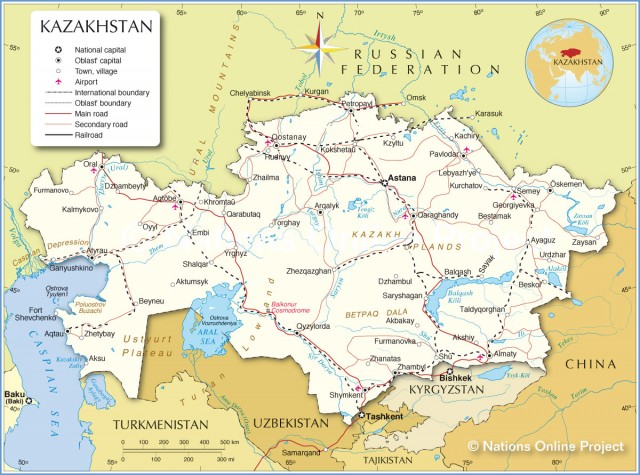Kazakhstan
Area 1,049,155 square mi (2,717,300 square km)
Population 17.29 million 2014
Capital Astana
Highest Point 23,084 ft (6,995 m)
Lowest Point -436 ft (-132 m)
GDP $212.2 billion 2014
Primary Natural Resources petroleum, natural gas, coal.
THE REPUBLIC OF Kazakhstan occupies the center of the Eurasian supercontinent, the second largest of the former Soviet republics and today the ninth-largest nation in the world. Most of its vast territory, stretching from the Caspian and Volga lowlands in the west to the ALTAI MOUNTAINS on the borders with CHINA, is flat, covered in arid semidesert or STEPPE. Its people have been nomadic herders for millennia but are now taking the lead in the development of industry, agriculture, and international trade for Central Asia.

Kazakhstan has no coastline, except for 1,174 mi (1,894 km) along the landlocked CASPIAN SEA. Its main trade corridor has therefore been across the land, connecting the commerce of its neighbors (RUSSIA, TURKMENISTAN, UZBEKISTAN, KYRGYZSTAN, and China), starting with the SILK ROAD in the Middle Ages, continuing with the development of railroads in the 20th century, and once again building its transportation links with China today. The Kazakh people are a mixture of Turkic and Mongol nomadic tribes who ruled the region through interlocked, kin-based khanates until gradual annexation by the Russian Empire in the 18th century.
After a brief attempt at autonomy in the 1920s, the region became a Soviet Republic in 1936. The Soviets initiated intense agricultural and industrial development projects in the northern steppes during the 1950s, which brought numerous immigrants—Russians, Ukrainians, Germans, and others—who eventually out-numbered the native peoples. The Kazakhs declared their independence in 1991, and the population has once again shifted, through both mass emigration and a higher birthrate among ethnic Kazakhs.
THREE REGIONS
Geographically, the country is mostly homogeneous, a great flat tableland of lowlands, plains, and plateaus. This can be broken up into three basic regions: the Volga and Caspian lowlands of the west (with the narrow, low Mugodzhar Mountains), the Turgai Plateau, and the Kazakh Steppe. The Turgai Plateau is characterized by a central depression with a chain of small lakes. Most of the area's rivers flow into these lakes, some of which evaporate and disappear completely during the dry season.
The Ulu-Tau mountains divide this area from the eastern third of the country, the Kazakh Steppe, which is mostly flat with a few scattered massifs. The primary of these elevated areas divides the watershed between the upper Irtysh River valley (whose waters flow across the West Siberian Plain all the way to the Arctic Sea) and Lake BALKASH, one of the largest lakes in the world in area, but not in volume, since it is very shallow. Lake Balkash is also very salty and has very little wildlife. South of these broad semi-desert and steppe plains are the northern edges of one of the great deserts of Central Asia, the Kyzyl Kum. Across this desert runs the other major river of Kazakhstan, the Syr Darya, which flows into the ARAL SEA. To the east and south rise the great mountain chains that divide Central Asia from China, the Altai, and Tian Shan.
Along the northern edges of Kazakhstan, several large cities were developed under the Soviet regime, the mining and industrial heart of Central Asia. Kazakhstan is a leading producer of coal, iron ore, manganese, copper, and many other minerals. It is oil and gas, however, that hold the most promise for the Kazakhs, with reserves estimated to put Kazakhstan into the top 10 oil producers in the world by 2015, especially around the Caspian Sea basin—the Tenghiz field ranks as one of the largest deposits in the world. Agriculture is still a major part of Kazakh economy, chiefly in grain exports and livestock.
Actively courting western investment and friendship, the Kazakhs declared their territory nuclear free in 1995, and the new national capital (Astana, moved in 1998, formerly known as Akmola, then as Tselinograd) lies inside a special economic zone with reduced trade barriers and tax incentives for investors. Russia continues to run the space center Baykonur Cosmodrome (formerly called Leninsk), but the Kazakh government is encouraging greater participation by ethnic Kazakhs.